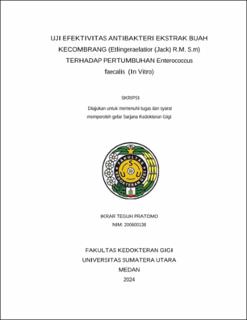Uji Efektivitas Antibakteri Ekstrak Buah Kecombrang (Etlingeraelatior (Jack) R.M. S.m) Terhadap Pertumbuhan Enterococcus faecalis (In Vitro)
Antibacterial Activity Assay of Kecombrang Fruit Extract (Etlingera elatior (Jack) R.M.Sm.) against the growth of Enterococcus Faecalis (In Vitro)

Date
2024Author
Pratomo, Ikrar Teguh
Advisor(s)
Bachtiar, Zulfi Amalia
Metadata
Show full item recordAbstract
Enterococcus facealis is a gram-positive facultative anaerobic bacteria in the
form of a coccus. Enterococcus facealis has long been known to play a role in root
canal infections and is resistant to medications during root canal treatment, causing
root canal treatment failure. The prevalence of infection caused by Enterococcus
facealis bacteria during root canal treatment is quite high ranging from 24%-77%. The
part of kecombrang (Etlingera elatior) that has been tested for effectiveness against
antibacterial properties, especially on E. faecalis bacteria, is the fruit. Kecombrang fruit
can inhibit the growth of E. faecalis bacteria at various concentrations and has potential
as an alternative irrigation material.
This type of research includes laboratory experimental research with a post test
only research design with controlled group design. The samples used were
Enterococcus faecalis and 70% ethanol extract of kecombrang fruit (Etlingera elatior)
with 8 test concentration groups and 2 control groups. The method used Kirby-Bauer
disc diffusion to determine the value of the minimum inhibitory concentration (KHM)
and streaking method from KHM testing to determine the value of the minimum kill
concentration (KBM). Data analysis of the results of the study to determine the value
of KHM and KBM using the One-Way ANOVA parametric test (p<0.05) and continued
with the Post Hoc Test (LSD).
The results showed that there was antibacterial activity of kecombrang fruit
extract (E.elatior) against the growth of Enterococcus faecalis bacteria. Kecombrang fruit extract (E.elatior) is able to inhibit the growth of Enterococcus faecalis bacteria
starting from a concentration of 35% with a mean inhibition zone diameter of 22.033
± 0.2517 mm and a killing power of 35% to a concentration of 60% with the smallest
killing power of 43.78% and a killing power of 98.85%.
This study concluded that the concentration of 35% was determined as the KHM
value. The KBM value among the test concentrations was at a concentration of 60%.
The effective concentration of kecombrang (Etlingera elatior) flower extract that has
inhibition and killing power so that it has the potential to become a root canal irrigation
material is 60% concentration.
Collections
- Undergraduate Theses [1908]
